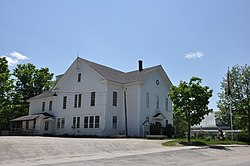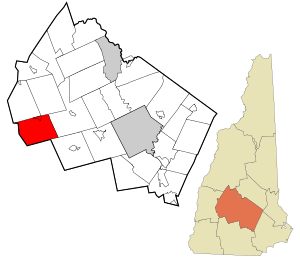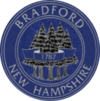Bradford, New Hampshire
| Bradford, New Hampshire | ||
|---|---|---|
| Town | ||

Bradford Town Hall
|
||
|
||
 Location in Merrimack County and the state of New Hampshire. |
||
| Coordinates: 43°16′12″N 71°57′36″W / 43.27000°N 71.96000°WCoordinates: 43°16′12″N 71°57′36″W / 43.27000°N 71.96000°W | ||
| Country | United States | |
| State | New Hampshire | |
| County | Merrimack | |
| Incorporated | 1787 | |
| Government | ||
| • Board of Selectmen | John Pfeifle, Chair Sonny Harris Jim Bibbo |
|
| • Town Administrator | Karen Hamilton | |
| Area | ||
| • Total | 36.0 sq mi (93.3 km2) | |
| • Land | 35.3 sq mi (91.5 km2) | |
| • Water | 0.7 sq mi (1.8 km2) 1.94% | |
| Elevation | 686 ft (209 m) | |
| Population (2010) | ||
| • Total | 1,650 | |
| • Density | 46/sq mi (18/km2) | |
| Time zone | Eastern (UTC-5) | |
| • Summer (DST) | Eastern (UTC-4) | |
| ZIP code | 03221 | |
| Area code(s) | 603 | |
| FIPS code | 33-06980 | |
| GNIS feature ID | 0873549 | |
| Website | www |
|
Bradford is a town in Merrimack County, New Hampshire, United States. The population was 1,650 at the 2010 census. The main village of the town, where 356 people resided at the 2010 census, is defined as the Bradford census-designated place (CDP), and is located west of the junction of New Hampshire routes 103 and 114. The town also includes the villages of Bradford Center and Melvin Mills.
Granted by Governor Benning Wentworth in 1765 to John Pierce and George Jaffrey of Portsmouth, it was settled in 1771 by Dea. William Presbury and family. Three years later other settlers arrived, several of them from Bradford, Massachusetts, after which the town was named New Bradford. Later, it was called Bradfordton, but upon incorporation by the General Court on September 27, 1787, it was officially named Bradford.
Parts of the town are hilly, but the largest portion is in a valley with varied soil. Streams provided water power for watermills. By 1859, when Bradford's population reached 1,341, industries included one woolen mill, one sash, blind and door factory, one wheelwright shop, two sawmills, one gristmill, one tannery, and one clothing mill. In 1850, the Concord & Claremont Railroad opened from Concord to Bradford, which would remain its terminus until the line was extended to Claremont in 1871-1872.
...
Wikipedia

